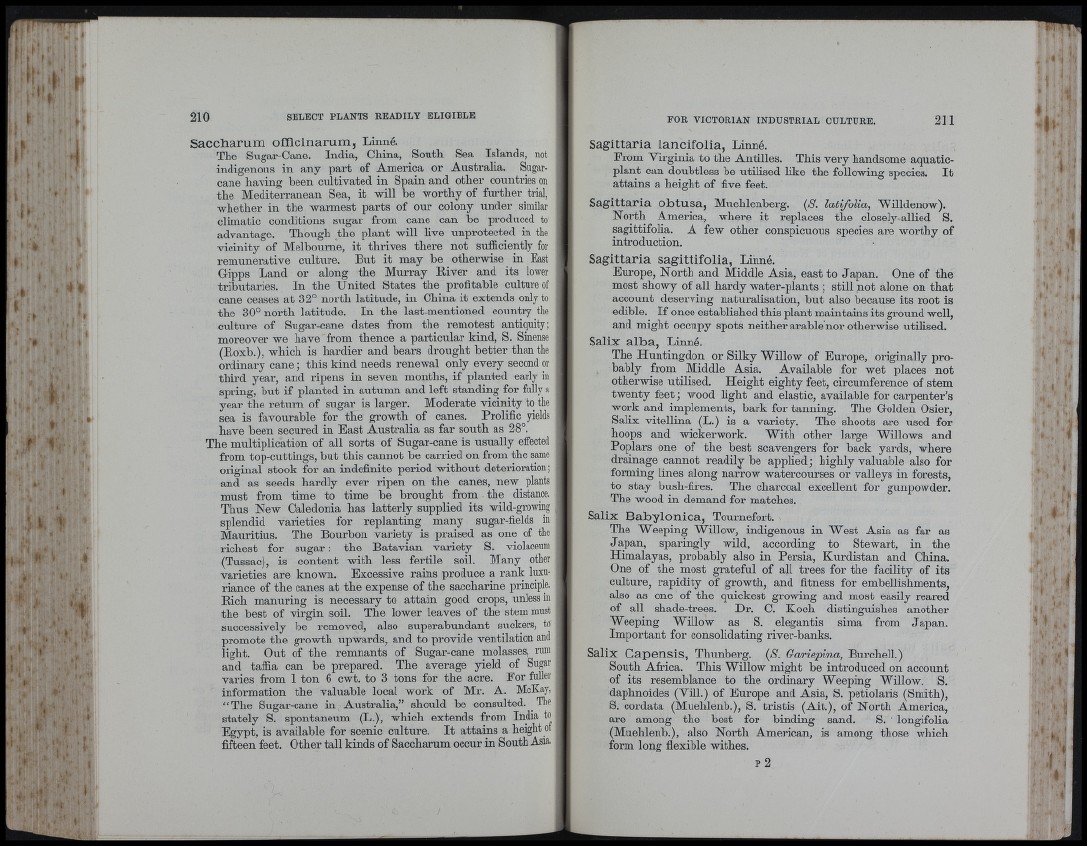
L i
♦
Saccharum offîcinarum, Linné.
The Sugar-Cane. India, China, South Sea Islands, not
indigenous in any part of America or Australia. Sugarcane
having been cultivated in Spain and other countries on
the Mediterranean Sea, it will be worthy of further trial,
whether in the warmest parts of our colony under similar
climatic conditions sugar from cane can be produced to
advantage. Though the plant will live unprotected in the
vicinity of Melbourne, it thrives there not sufficiently for
remunerative culture. Bnt it may be otherwise in East
Gipps Land or along the Murray River and its lower
tributaries. In the United States tbe profitable culture of
cane ceases at 32° north latitude, in China it extends only to
the 30° north latitude. In tbe last-mentioned country the
culture of Sugar-cane dates from tbe remotest antiquity;
moreover we have from thence a particular kind, S. Sinense
(Roxb.), wbicb is hardier and bears drought better than the
ordinary cane ; this kind needs renewal only every second or
third year, and ripens in seven months, if planted early in
spring, but if planted in autumn and left standing for fully a
year the return of sugar is larger. Moderate vicinity to the
sea is favourable for tbe growth of canes. Prolific yields
have been secured in East Australia as far south as 28°.
The multiplication of all sorts of Sugar-cane is usually effected
from top-cuttings, but this cannot be carried on from the same
original stook for an indefinite period without deterioration;
and as seeds hardly ever ripen on the canes, new plants
must from time to time be brought from the distance,
Tbus New Caledonia has latterly supplied its wild-growing
splendid varieties for replanting many sugar-fields in
Mauritius. The Bourbon variety is praised as one of the
richest for sugar : tbe Batavian variety S. violaceum
(Tussac), is content with less fertile soil. Many other
varieties are known. Excessive rains produce a rank luxuriance
of the canes at tbe expense of the saccharine principle.
Rich manuring is necessary to attain good crops, unless in
the best of virgin soil. Tbe lower leaves of tbe stem must
successively be removed, also superabundant suckers, to
promote tbe growth upwards, and to provide ventilation and
light. Out of tbe remnants of Sugar-cane molasses, mm
and taffia can be prepared. The average yield of Sugar
varies from 1 ton 6 cwt. to 3 tons for the acre. For fuller
information tbe valuable local work of Mr. A. McKay,
“ The Sugar-cane in Anstralia,” should be consulted. _ The
stately S. spontaneum (L.), which extends from India to
Egypt, is available for scenic culture. I t attains a height of
fifteen feet. Other tall kinds of Saccharum occur in South Asia.
Sagittaria lancifolia, Linné.
From Virginia to the Antilles. This very handsome aquatic-
plant can doubtless be utilised like the following species. I t
attains a height of five feet.
Sagittaria obtusa, Muehlenberg. (S. latifolia, Willdenow).
North America, where it replaces the closely-allied S.
sagittifolia. A few other conspicuous species are worthy of
introduction.
Sagittaria sagittifolia, Linné.
Europe, North and Middle Asia, east to Japan. One of the
most showy of all hardy water-plants ; still not alone on that
account deserving naturalisation, but also because its root is
edible. I f once established this plant maintains its ground well,
and might occupy spots neither arable'nor otherwise utilised.
Salix alba, Linné.
The Huntingdon or Silky Willow of Europe, originally probably
from Middle Asia. Available for wet places not
otherwise utilised. Height eighty feet, circumference of stem
twenty feet; wood light and elastic, available for carpenter’s
work and implements, bark for tanning. The Golden Osier,
Salix vitellina (L.) is a variety. The shoots are used for
hoops and wickerwork. With other large Willows and
Poplars one of the best scavengers for back yards, where
drainage cannot readily be applied; highly valuable also for
forming lines along narrow watercourses or valleys in forests,
to stay bush-fires. Tbe charcoal excellent for gunpowder.
The wood in demand for matches.
Salix Babylonica, Tournefort.
The Weeping Willow, indigenous in West Asia as far as
J apan, sparingly wild, according to Stewart, in the
Himalayas, probably also in Persia, Kurdistan and China.
One of the most grateful of all trees for the facility of its
culture, rapidity of growth, and fitness for embellishments,
also as one of the quickest growing and most easily reared
of all shade-trees. Dr. C. Koch distinguishes another
Weeping Willow as S. elegantis sima from Japan.
Important for consolidating river-banks.
Salix Capensis, Thunberg. (S. Gariepina, Burchell.)
South Africa. This Willow might be introduced on account
of its resemblance to the ordinary Weeping Willow. S.
dapbnoides (Vill.) of Europe and Asia, S. petiolaris (Smith),
S. cordata (Muehlenb.), S. tristis (Ait.), of Noi'th America,
are among the best for binding sand. S. ’ longifolia
(Muehlenb.), also North American, is among those which
form long flexible withes.
I